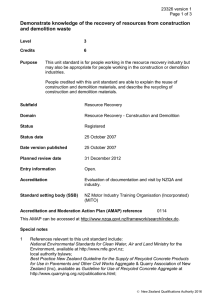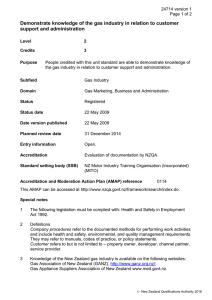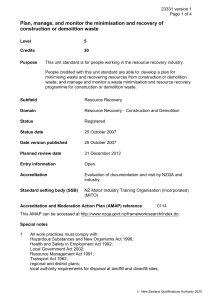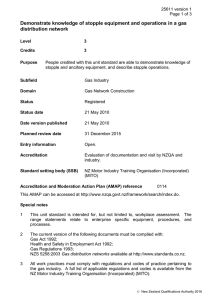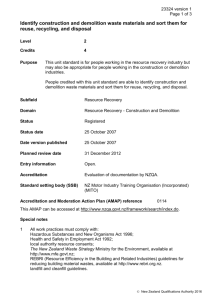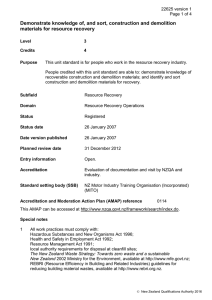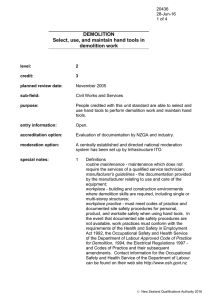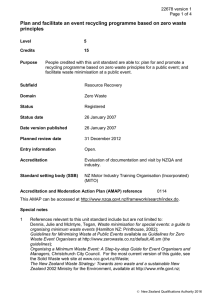Recommend minimisation and resource recovery strategies for construction and demolition waste
advertisement
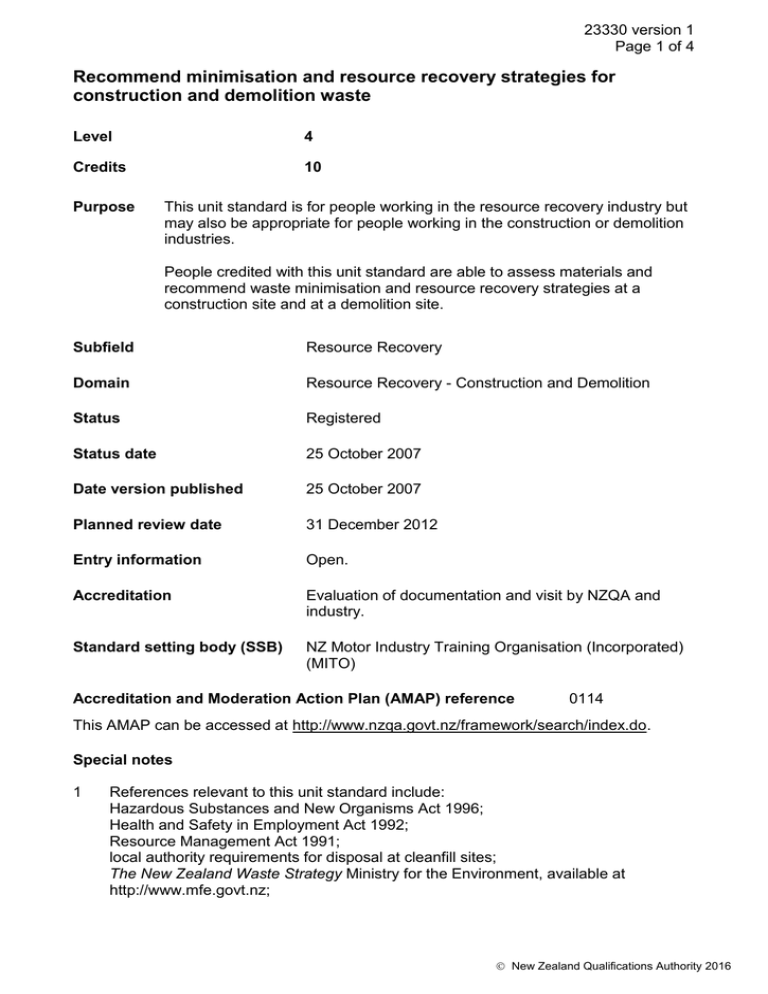
23330 version 1 Page 1 of 4 Recommend minimisation and resource recovery strategies for construction and demolition waste Level 4 Credits 10 Purpose This unit standard is for people working in the resource recovery industry but may also be appropriate for people working in the construction or demolition industries. People credited with this unit standard are able to assess materials and recommend waste minimisation and resource recovery strategies at a construction site and at a demolition site. Subfield Resource Recovery Domain Resource Recovery - Construction and Demolition Status Registered Status date 25 October 2007 Date version published 25 October 2007 Planned review date 31 December 2012 Entry information Open. Accreditation Evaluation of documentation and visit by NZQA and industry. Standard setting body (SSB) NZ Motor Industry Training Organisation (Incorporated) (MITO) Accreditation and Moderation Action Plan (AMAP) reference 0114 This AMAP can be accessed at http://www.nzqa.govt.nz/framework/search/index.do. Special notes 1 References relevant to this unit standard include: Hazardous Substances and New Organisms Act 1996; Health and Safety in Employment Act 1992; Resource Management Act 1991; local authority requirements for disposal at cleanfill sites; The New Zealand Waste Strategy Ministry for the Environment, available at http://www.mfe.govt.nz; New Zealand Qualifications Authority 2016 23330 version 1 Page 2 of 4 REBRI (Resource Efficiency in the Building and Related Industries) guidelines for reducing building material wastes and reports, available at http://www.rebri.org.nz. 2 Definitions Building components refer to fittings, structural materials and cladding. Company procedures means the documented methods for performing work activities and include health and safety, environmental, and quality management. Sites refer to construction and demolition sites. These may be commercial, industrial, domestic or any combination. Elements and performance criteria Element 1 Assess materials and recommend waste minimisation and resource recovery strategies at a construction site. Range at least one site. Performance criteria 1.1 A review of construction plans identifies and records specified material types and quantities. Range materials include but are not limited to – structural, roofing, wall lining, doors and windows, electrical, plumbing and drainage, fittings. 1.2 Specified materials are assessed for sustainability in accordance with Ministry for Environment targets, and industry guidelines. 1.3 A site inspection identifies and quantifies building components that may be diverted from the waste stream, and recommends collection methods for separating single-item salvage from mixed waste. Range 1.4 The recommendations comply with acceptance criteria of local facilities in accordance with legislation and bylaws. Range 1.5 components may include but are not limited to – timber, concrete, plasterboard, reinforcing bar, electrical wiring, plastics, insulation. facilities – recycling, hazardous waste, cleanfill, landfill; criteria include but are not limited to – material type, minimum quantity, maximum quantity. The recommendations are consistent with current markets for materials. Range currency may be determined from – local recovery facilities, waste exchange directories, industry websites. New Zealand Qualifications Authority 2016 23330 version 1 Page 3 of 4 Element 2 Assess materials and recommend waste minimisation and resource recovery strategies at a demolition site. Range at least one site. Performance criteria 2.1 A site inspection identifies and records materials that may be salvaged for recovery. Range 2.2 A site inspection identifies and quantifies demolition materials that may be diverted from the waste stream, and recommends collection methods for separating single-item salvage from mixed waste. Range 2.3 salvage may include but is not limited to – timber, concrete, plasterboard, reinforcing bar, electrical wiring, plastics, insulation, vegetation. The recommendations comply with acceptance criteria of local facilities in accordance with legislation and bylaws. Range 2.4 materials include but are not limited to – structural, roofing, wall lining, doors and windows, electrical, plumbing and drainage, fittings. facilities – recycling, hazardous waste, clean fill, landfill; criteria include but are not limited to – material type, minimum quantity, maximum quantity. The recommendations are consistent with current markets for materials. Range currency may be determined from – local recovery facilities, waste exchange directories, industry websites. Please note Providers must be accredited by NZQA, or an inter-institutional body with delegated authority for quality assurance, before they can report credits from assessment against unit standards or deliver courses of study leading to that assessment. Industry Training Organisations must be accredited by NZQA before they can register credits from assessment against unit standards. Accredited providers and Industry Training Organisations assessing against unit standards must engage with the moderation system that applies to those standards. New Zealand Qualifications Authority 2016 23330 version 1 Page 4 of 4 Accreditation requirements and an outline of the moderation system that applies to this standard are outlined in the Accreditation and Moderation Action Plan (AMAP). The AMAP also includes useful information about special requirements for organisations wishing to develop education and training programmes, such as minimum qualifications for tutors and assessors, and special resource requirements. Comments on this unit standard Please contact the NZ Motor Industry Training Organisation (MITO) info@mito.org.nz if you wish to suggest changes to the content of this unit standard. New Zealand Qualifications Authority 2016

